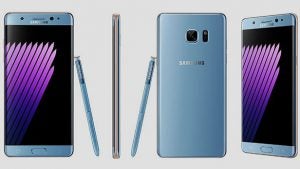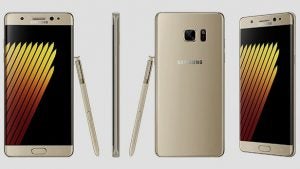Samsung Galaxy Note 7 vs Galaxy S7: What’s the difference?
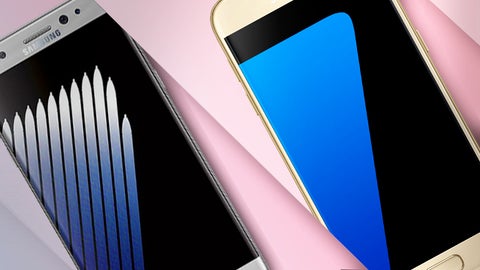
Samsung Galaxy Note 7 vs Galaxy S7: Samsung’s high-end phablet takes on its flagship smartphone.
Earlier this year, Samsung introduced what might be the best Android phone yet in the form of the Galaxy S7. We loved the top-end specs, refined design, and especially Samsung’s attempts to make the TouchWiz UI less intrusive.
But now, the premium Galaxy Note 7 has arrived, and the S7 has a seriously powerful competitor, albeit from the same company.
We’re yet to review the Note 7, but all signs point towards a very capable device with a host of innovative features. With that in mind, we thought we’d take an early look at how the S7, and its curvy cousin the S7 Edge, compare to the Note 7.
Here’s everything you need to know.
Related: Galaxy Note 7 vs iPhone 6S Plus
VIDEO: Galaxy S7 review
Samsung Galaxy Note 7 vs Galaxy S7 – Design
First up, measurements. The Note 7 comes it at 153.5 x 73.9 x 7.9mm and weighs 169g. That makes it more bulky overall than the S7, which is 142.4 x 69.6mm but measures the same 7.9mm when it comes to thickness. It’s also much lighter at 152g.
Interestingly, the S7 Edge, which is almost the same size as the Note, at 150.9 x 72.6mm, is very slightly thinner than both the Note and the S7, coming in at 7.7mm. That’s no doubt down to the larger case, at least when you consider it alongside the standard S7. But the Note 7 is larger still, and we’d have expected it to be as thin as the Edge at least, especially considering it’s got a smaller battery. Perhaps all the S Pen stylus tech adds to the bulk?
Either way, the Note 7 is the larger of all the devices, as you’d expect from a phablet, and it’s not much thicker than the S7 Edge.
Related: Hands on with the Galaxy Note 7
When it comes to colours, the Note 7 comes in a choice of three hues – Black Onyx, Silver Titanium, and Blue Coral (which is new). The S7, in contrast, comes in a few more options: black, gold, white, silver, or the delightfully gaudy pink gold.
Colours are all well and good, but what are these phones actually made of? Well, Samsung can’t be faulted when it comes to its flagship phone. The materials and build quality on the S7 and S7 Edge are stellar. Dare we say, spellbinding? No, on second thoughts, stellar will do.
Both the standard phone and the Edge variant are made from metal alloy with a glass front and back. The Edge obviously has those sleek curves working in its favour, but then, so does the Note 7. With a dual-curved-edge design, the Note 7 looks a lot like the S7 Edge, which certainly isn’t a bad thing. It also has the benefit of stronger Gorilla Glass 5, which makes its debut on the new handset.
Watch: Galaxy Note 7 hands-on
All these devices are also IP68 rated, which means you can dunk them in 1m of water for up to 30 minutes without damaging them.
In all, the S7, S7 Edge, and Note 7 are fantastic-looking handsets. While the dual curved edges of the Note 7 definitely add something to the overall design, the S7 itself is more compact, which will always help it look that extra bit sleeker. This one is going to depend on personal preference, then. (But no one’s ever looked cool whipping out a phablet, if you ask us.)
Samsung Galaxy Note 7 vs Galaxy S7 – Display
Perhaps one of the most important elements of a smartphone is its screen, and Samsung has made efforts to ensure its 2016 range of handsets can compete with the best. Both the S7 and S7 Edge come with Super AMOLED displays, with a QHD resolution of 2,560 x 1,440. While the standard model has a 5.1-inch screen, the Edge features a slightly larger 5.5-inch offering. In both cases, the resolution is enough to ensure crisp images. You won’t be noticing any individual pixels on these things.
So, what has the company done when it comes to its premium Note 7 device? Well, the larger 5.7-inch display features the same 2,560 x 1,140 resolution, which, again, provides more than enough pixels per inch to ensure a sharp picture. But this is a higher-end device after all, so there had to be some improvements over the S7 range. And that comes in the form of Mobile HDR, which we’re obviously yet to test out in full, but should provide some pretty vivid pictures.
If you’re confused about HDR, we’ve got a full What is HDR? guide you can check out. In short, you should expect greater detail in the darkest and lightest areas of the picture, improving realism overall – although we’re sceptical about how effective HDR can be on a smartphone screen.
Related: Best smartphone
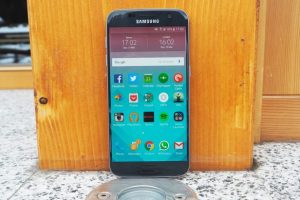
One other major difference between the S7 and the Note 7 is, of course, the S Pen. Samsung’s stylus now comes with a number of improvements packed in. The pen is now water-resistant, coming with the same IP68 rating as the phablet itself, so you can stop during a rain storm to jot down a few thoughts.
It also works when the screen is locked, and has a pressure sensor which can register 4,096 levels of pressure. None of this can be done on either the S7 or the S7 Edge, which don’t support the S Pen.
The other thing to note when it comes to the different displays is that, as we mentioned,
Overall then, it could be the case that, due to its smaller size, images on the S7 will appear slightly sharper than on the Note 7. But, as both have a QHD display, the difference should be negligible. The Mobile HDR on the Note 7 could make a difference, but we’re yet to see any evidence, and the phablet will no doubt hold up better when dropped. With all that in mind, we have to give this one to the Note.
Samsung Galaxy Note 7 vs Galaxy S7 – Hardware
When it comes to performance and hardware, you’d expect the Note 7, Samsung’s most premium device, to have the edge over its slightly lesser cousins. With an octa-core Snapdragon 820 or Exynos 8890 CPU (depending on where you live), 4GB of LPDDR RAM, and 64GB internal storage, however, you’re looking at an identical set of specs to those of the S7 and the Edge.
Related: Note 7 vs Note 5 vs Note 4
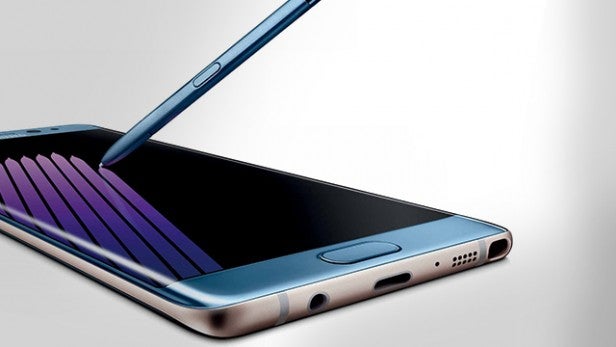
That’s right, the Note 7 doesn’t offer any significant performance advantages over its smaller counterparts. In fact, it offers none at all, which may surprise you, but when you consider that the S7 is still the most powerful phone you can buy, it’s kinda hard to complain.
In day-to-day usage, then, these handsets are plenty fast. There’s a good 30% boost in CPU performance and 64% in GPU performance over the Exynos 7 chip used in the S6.
The only significant hardware difference between the S7/Edge and the Note 7 is the inclusion of an iris scanner on the latter. You can use this in certain apps as well as to unlock the phone, and Samsung assures us it’s secure and easy to use. We’ll have more on that once we’ve reviewed the phone.
One other slight difference worth mentioning is that the Note 7 only comes with 64GB of internal storage, whereas the S7 and S7 Edge can be bought with either 32GB or 64GB. Either way, you can whack a microSD card in all of these phones, so it’s not really a big deal.
Without any major differences between the handsets, then, it’s difficult to call a winner in the hardware division. There is, of course, the S Pen to take into account, and the extra functionality that brings to the table. But when it comes down to it, performance should be similarly spectacular across all these devices.
Samsung Galaxy Note 7 vs Galaxy S7 – Software
Another area where things remain relatively similar is software. Google isn’t quite ready to unleash Android Nougat’s final version upon the masses just yet, and as such, the Note 7 will arrive with good old Android Marshmallow. And that’s exactly what you’ll find on the S7 and S7 Edge, too.
Related: Galaxy Note 7 UK release date and price – how to pre-order
Thankfully, Marshmallow is a great OS which worked perfectly well on the S7, especially since Samsung seems to have done all it can to tone down the intrusiveness of TouchWiz. The company’s Android skin has been a major drawback for all Galaxy phones, with its seemingly needless graphical overlays and duplicate apps. Luckily, this time around, it’s not quite so irritating,
Interestingly, Samsung promises a streamlined UI, featuring less colours on the Note 7, which we can only imagine is to give users the feeling that the extra cash they shelled out for the phablet was worth it for the understated aesthetics, as it doesn’t seem to alter functionality in any way.
The Note will also obviously come with special software to support the S Pen. Samsung Notes, which lets you draw (oil paintings, apparently – just what we’ve always wanted…), handwrite and edit images, is included, alongside a few more S Pen apps, we suspect.
What’s the upshot when it comes to software, then? You guessed it: no real difference. Notice a theme here?
Samsung Galaxy Note 7 vs Galaxy S7 – Camera
For some, the camera on a phone is as important as anything else, and Samsung has made sure to please the lens lads and lasses with the S7 and S7 Edge. Both phones have exactly the same cameras, which is a good thing, as it happens to be a seriously capable setup.
The S7 and S7 Edge come with a 12-megapixel camera with phase detection, Dual Pixels, OIS, an f/1.7 lens, and a 1/2.6-inch sensor. The drop in megapixels from 16 on the S6 to 12 on the S7 and S7 Edge, along with the same-sized sensor, allows for larger 1.4µm pixels. That means the camera on these things is capable of fantastic low-light performance, helped by the bright f/1.7 lens.
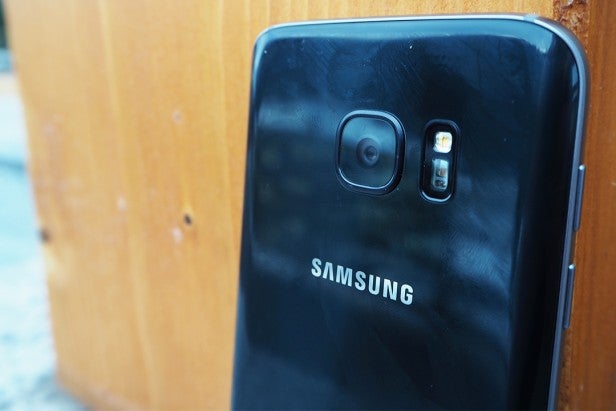
You’ll also be able to shoot 4K video, and the 5-megapixel front camera is more than adequate for a Skype sesh and the odd selfie.
So what does the Note 7 do better than the S7 and the S7 Edge in terms of camera capability? Nothing. It’s the same. And that’s all there is to it. No matter which device you pick up, you can expect the same outstanding performance from the camera setup – which is, when it comes down to it, a positive.
Samsung Galaxy Note 7 vs Galaxy S7 – Battery
The 3,500mAh battery in the Note 7 is a tad more capacious than the 3,000mAh offering in the S7. Surprisingly, though, it’s actually slightly smaller than the one in the S7 Edge, which comes with a 3,600mAh battery.
In our experience, the S7 and its curvy counterpart will last you a day easily, even with moderate to high usage, although the Edge’s battery is undoubtedly the more powerful of the two. When it comes to the Note, we expect a similar situation.
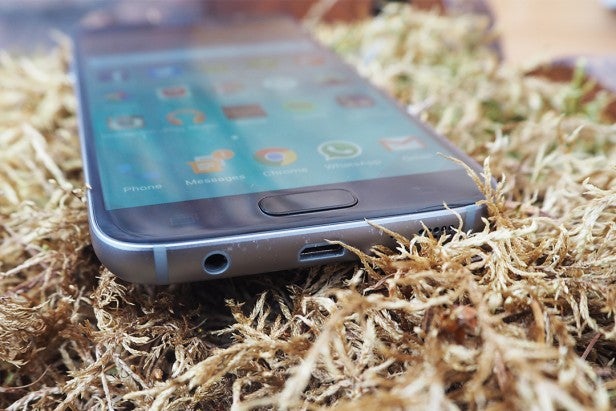
But, it’s worth noting that, in our tests, the Edge was left with around 25-35% battery after a day of moderate to high usage. That’s with a 3,600mAh battery. The Note 7, in contrast, has to power a bigger screen and stylus functionality. Both phones run on Android Marshmallow, so the Note doesn’t have any power-saving features that the Edge doesn’t.
All of this has us slightly – and we mean slightly – concerned that the Note 7 won’t offer quite the battery performance we were hoping for. That said, we’re yet to test it out, so we can’t say for sure at this point whether the Note 7’s cell is up to the task or not.
Samsung Galaxy Note 7 vs Galaxy S7 – Price & Release Date
The S7 and S7 Edge have been available for a few months now, and you can currently get your hands on the former for around £550, and the latter for around £630. These prices will obviously come down as the months go on, but that’s what you’re looking at for the time being.
The Note 7 has been given a September 2 release date by Samsung, and will go on sale for an eye-watering £749. While it’s obviously a premium device, that’s a lot of money to shell out, especially when you consider the Galaxy S7 and S7 Edge are equally capable when it comes to performance.
Summary
There’s no doubt the Note 7 is a more capable device than the S7 and the S7 Edge. The S Pen support alone adds a load more functionality, and you’ve got the extra iris scanner to consider. But it’s also a more bulky device. The increased screen size means the Note 7 isn’t the slickest-looking thing around.
Overall, then, you can’t really go wrong with any of these Samsung handsets. The Note 7 and the S7 should be identical in terms of performance, offering the fastest and most advanced user experience you can currently get in a smartphone.
Buy Now: Galaxy Note 7 at Amazon.com from $969
Which one you choose will be down to which design you prefer, whether you need a stylus, and whether you mind carrying the extra weight around. As such, there’s no clear winner here. In terms of features, the Note 7 clinches it. In terms of portability and affordability, it’s the S7.
Buy Now: Galaxy S7 at Amazon.com from $579.99
We’ll have more once we get our hands on the Note 7 for a full review.
WATCH: What’s the no.1 smartphone in the world?
Which phone do you think is best? Let us know in the comments below.

